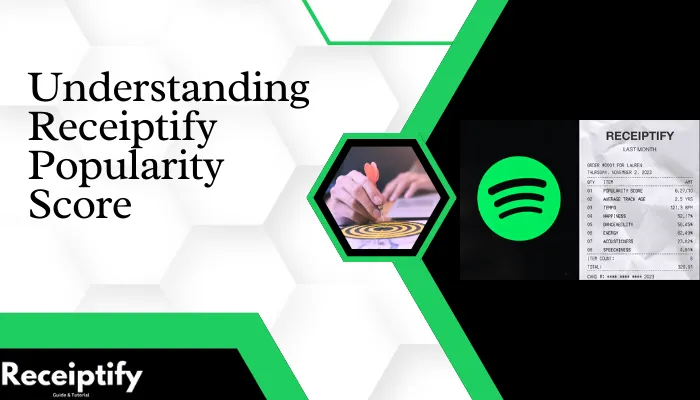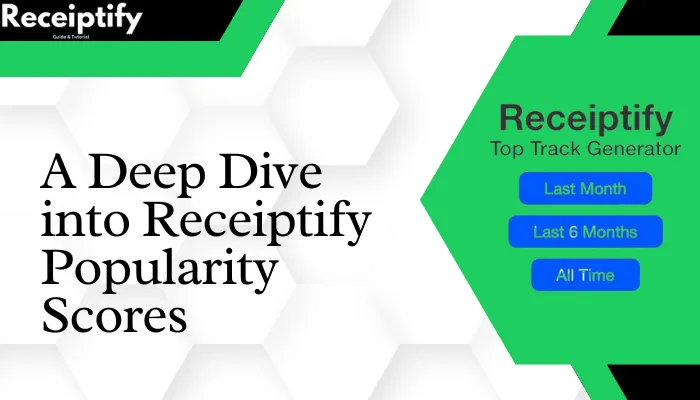Receiptify Popularity Score is a metric analyzing user engagement and preferences to tailor personalized recommendations and enhance satisfaction.Have you ever scrolled through social media and come across a pretty “receipt” of someone’s music taste?

That, my friend, is Receiptify – an online tool that fun-ifies your listening history into a shareable grocery list, with song titles as items and playtime as prices. But behind the funky visuals lies a potential treasure – the Receiptify Popularity Score.
This article explores what Receiptify Popularity Scores mean and their importance. We will also discuss why customer feedback analysis is essential in businesses by drawing parallels from how Receiptify provides insights about your musical preferences and also know What do the numbers mean on Receiptify?.
Receiptify Popularity Score
Hang on – it does not give out any traditional scores like exam marks! Instead, this feature represents visually the amount of time you spend listening to different songs using playtime. The longer (more frequently) a track appears on your receipt means higher popularity within your musical library.
Think of it as a personal Spotify Wrapped but in one sheet of paper; which can be really fun to see who tops the charts when it comes to most played artists or genres.

How Does It Work?
Here is where all the magic happens:
Connecting Your Streaming Service: Receiptify connects with popular music streaming services like Spotify, Apple Music or even Last.fm.
Data Access: Once authorized, Receiptify fetches information about what you have been listening to mainly focusing on time played for each track.
Receipt Generation: The coolest part! It takes this data and makes it look like a receipt where titles become items and playtime turns into prices. Longer duration means higher value on this sheet of paper called the Receiptify Popularity Score receipt.
Note: This is not an industry standard measure of popularity but just a way to represent that visually.Key Components and Metrics Considered
While there are no numerical scores provided by Receiptify, they do take into account one key metric:
Playtime: The more frequently a song has been played (longer durations) affects its “price” on your receipt i.e., perceived popularity among personal listening preferences based on this single factor alone.
This single metric paints a vivid picture of your musical obsessions. If a track lingers around too much time then it means more love from me
Let’s take a closer look at the technical side of things and consider some other use cases beyond just musical preferences with Receiptify Popularity Scores.
The Technology Behind Receiptify Popularity Scores
Though it may seem like a simple, fun tool, there is actually quite a bit of interesting technology behind those personalized receipts from Receiptify.
Data Collection Methods
To create your music profile, Receiptify uses secure methods to collect data:
| API Integration: | Receiptify connects securely with your music streaming service of choice (such as Spotify or Apple Music) through its Application Programming Interface (API), which lets Receiptify view your listening history but more specifically looks at how long you spend on each song. |
| User Consent: | Before generating a receipt for you, Receiptify will ask for permission to access your streaming service data. This ensures that users know what information is being collected about them and have control over it. |
Important Note: Listening data is the only personal information collected by Receiptify.
Machine Learning Algorithms (Not Applicable)
Receiptify doesn’t necessarily employ complex machine learning algorithms in the way you might expect with a “popularity score.” Although it does use data, the core function has more to do with retrieval and processing than anything else – along with presenting everything in visually appealing ways.
In short: why machine learning might not be involved?
| Limited Scope: | All that’s being analyzed here is playtime; nothing like genre classification or music recommendation requires elaborate algorithms. |
| Simplicity and Speed: | One of the strengths of this tool lies in its simplicity coupled with speediness; if complicated algorithms were utilized it could slow down how quickly receipts can be made. |
Receiptify makes sure that it clearly represents what you listen to based on how quickly this information can be processed.
Integration with Point-of-Sale Systems (Not Applicable)
It’s worth noting that Receiptify does not integrate with point-of-sale systems commonly found in retail businesses. The association created by the term “receipt” may suggest otherwise, but what Receiptify really does is look at and illustrate your music listening habits.
Now let’s move on from the technical side of things and look into other areas where Receiptify Popularity Scores can be used outside of just music.
Detailed Information About Receiptify Popularity Scores
So now that we have some knowledge about how it works, let’s think about everything else it could do! While it might seem like a fun tool for showing off our musical quirks, there are still many more lessons to learn from Receiptify Popularity Scores beyond just our playlists.
Applications and Benefits
Analyzing user behavior through data visualization is not limited to music alone; these same principles can be applied across different industries for businesses to gain insight about their customers. Here’s an exciting comparison offered by Receiptify Popularity Scores:
Improving Customer Experience
- Understanding Preferences: For example if you see a long song on your receipt then you know that this person really liked that song so much, similarly with customer behavior analysis we can tell which products or services resonate most with them.
- Tailored Recommendations: If a music platform recommends songs based on what I am listening to – why shouldn’t businesses recommend products or services they think I’ll love?
- Innovation Inspiration: Receiptify’s entertaining representation of information can motivate organizations to find new methods of displaying consumer data, thereby deepening their knowledge about customer preferences and needs that in turn stimulates product innovation.
Example: A fitness app can look at user workout data to figure out which exercises are popular and which areas are being ignored. This could be used to create new workouts or features.
Competitive Analysis and Market Insights
- Benchmarking: It’s like comparing your Receiptify receipt with a friend’s and seeing the different songs you both listen to — businesses can also compare themselves against competitors by analyzing customer data.
- Market Trends: Looking at customer behavior across a wider audience might show us some market trends. This allows businesses to stay ahead of the game and adjust their strategies accordingly.
Example: Streaming services should analyze user data so they know what new types of music are becoming popular. This can guide content acquisition strategies and playlist curation.
Receiptify Popularity Scores may seem silly, but they demonstrate how powerful data visualization combined with an understanding of customer behavior can be in gaining insights applicable across all sectors where businesses operate today amid ever-changing markets.
They also suggest what could happen if more companies took this approach towards understanding their consumers better by knowing What do the numbers mean on Receiptify? – so don’t just think it’s about weird representations on your receipt when sharing them around!
So next time you generate a Receiptify receipt and share it with friends, remember – this is not only a quirky way of showing your music taste but also proof that numbers have power beyond our imagination when harnessed correctly.
We’ve covered what Receiptify Popularity Scores are, how they work, why they matter, where else we could use this concept beyond receipts; now let’s look at some real-life examples where businesses have successfully used similar techniques for analysis-based decision-making.
Case Studies and Success Stories
While businesses do not use Receiptify directly, it serves as a metaphor for how companies can utilize customer behavior analysis. Here are some instances where data helped them understand their clientele better:
Examples of Businesses Implementing Receiptify Popularity Score Concepts
| Industry | Example | Description |
|---|---|---|
| Streaming Services | Netflix & Spotify | Analyze user habits for personalized recommendations, enhancing user experience and prolonging engagement. |
| Retail Giants | Amazon | Utilizes purchase history analysis to suggest complementary products, boosting customer satisfaction and average order value. |
| Subscription Services | Peloton | Tracks workout data to create personalized fitness plans based on popular routines, leading to increased user retention and satisfaction. |
These are just but a few examples; there is no limit when it comes to what organizations can achieve through being driven by information across different sectors within the economy.
Quantifiable Results and Impact on Business Operations
The following highlights show the power behind data-driven decision-making:
- Increased Customer Satisfaction: Through understanding what customers like or dislike about certain products this will enable companies to offer them exactly what they want thus leading to higher levels of satisfaction which in turn breeds loyalty among consumers.
- Improved Sales and Revenue Streams: One way would be using insights gained from such analyses during marketing campaigns where only those likely to respond positively should be targeted for instance also when coming up with new items should take into account these findings hence boosting sales figures over time.
- Enhanced Operational Efficiency: Another benefit entails applying knowledge acquired concerning patterns exhibited by various individuals in terms of behavior so that resources can be channeled appropriately thus reducing unnecessary wastage while at the same time improving efficiency within operations management itself.
Certainly! Here’s the information organized into a table:
| Business Area | Potential Impact |
|---|---|
| Customer Satisfaction | Increased customer retention, positive word-of-mouth marketing |
| Sales & Revenue | Marketing Campaigns, Product Development for Data, Pricing Optimization |
| Operational Efficiency | Process Streamlining, Resource Allocation Based on Customer Needs |
Utilizing customer behavior data effectively empowers businesses to unlock significant benefits beyond imagination.
Testimonials from Users and Experts
This is what people have to say about data analysis:
“We have used data analysis to learn more about our customers’ preferences and adapt our services accordingly.” – Marketing Director, Streaming Service
“Through user behavior analysis we were able to create a personalized experience that resonates with each one of our subscribers.” – Product Manager, Fitness App
“Customer data analysis has become an essential tool in optimizing marketing campaigns with higher ROI.” – CEO, E-commerce Platform
These testimonials show that many people now see customer behavior analysis as the key driver of success in business.
Nonetheless, there are some considerations which need to be taken into account when dealing with such powerful tools; ethical issues surrounding them shall be discussed in this next section.
A Deep Dive into Receiptify Popularity Scores
The potential brought by data analytics cannot be underestimated but it must also not overshadow the challenges and ethics associated with harnessing customer behavior information.

Challenges and Ethical Considerations
As corporations start realizing how important it is to work with facts they should also know where they might go wrong or what may be considered unethical when using these figures. Here are few areas:
Privacy Concerns and Data Security
- User Consent: Ensure that you get authorized permission from users before collecting any information about them which will later be analyzed statistically.
- Data Security Measures: Put necessary precautions to protect user’s personal identifiable information (PII) against unauthorized access or damage during storage/transmission.
- Transparency and Control: Make sure people know how their data is used so that they can either allow or deny it to be utilized for other purposes.
Remember: Trust should never be taken for granted, and it cannot be demanded. A responsible use of data will only encourage consumers to share more with us in the future.
Potential Biases and Fairness Issues
- Algorithmic Bias: Design your algorithms right; otherwise, you might end up reinforcing existing prejudices instead of eliminating them through analysis.
- Fairness in Decision-Making: Always strive to make fair decisions based on customer behavior insights without excluding any group from benefiting equally from such findings.
- Human Oversight: Even though we rely on computers heavily when dealing with large datasets, there must always remain room for human intervention so that ethical considerations are not overlooked completely during decision-making process driven by facts alone.
We have to ensure that all biases are taken into account if we want this information about our customers’ needs to work effectively and fairly.
Regulatory Compliance and Legal Implications
- Data Privacy Regulations: Companies must conform to various laws governing collection, storage, dissemination etc., of customer personal information like GDPR (General Data Protection Regulation) Act.
- Data Ownership and Usage Rights: Who owns what? What can a business do with user data while still respecting legal boundaries?
- Staying Informed: Keep up-to-date knowledge regarding changes made within privacy policies around the world so as not to get caught off guard by new developments affecting how we handle clients’ private details.
Failure to observe rules put in place concerning gathering using client records could lead to serious trouble hence important always stay lawful during these activities which may expose enterprise unnecessary risk
Conclusion
To sum up, Receiptify Popularity Scores, even though they were made for fun with music in mind, do have some serious implications about what can be done with data visualization and analyzing consumer behavior.
Any company that uses this approach correctly will open itself up to all sorts of opportunities such as improving customer loyalty or driving innovation while still maintaining long-term viability. Nevertheless, it is crucial not only being ethical but also complying with laws so as not only to protect the privacy of others but also establish trust between different enterprises and individuals based on proper use of information.
